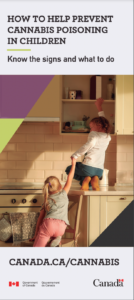While cannabis is a legal substance for adults in Canada, remember that this drug, just like alcohol and prescription drugs, can do serious harm to children and needs to be stored securely.
Between 2015 and 2021, 581 children under 10 years old were hospitalized for cannabis poisoning in Canada.
Children are more sensitive to the effects of the active ingredients in cannabis
It’s detrimental to the developing brain and has been linked to the development of psychosis in youth. A child may be naïve to cannabis and may have unexpected effects from an exposure.
Edible cannabis products became legal in Canada in 2019. Parents and other adults need to remember that edibles look like the sweet snacks most kids love: from brownies to gummy bears, a child (or an adult) can’t see the difference between an edible and the same products without cannabis.
Follow our hashtag #HighAndLocked on social media to learn more.
Cannabis safety and exposure prevention tips
If you choose to have cannabis in your home, follow these safety tips to ensure children are not mistakenly exposed to the drug.
Purchase legal products from a licensed seller
Legal cannabis products must follow Health Canada’s regulations. Products that do not meet these requirements may not have some of the features meant to keep everyone, but especially children, safe.
- Licensed sellers in Canada must follow regulations for packaging their products, including child-resistant containers and clear labelling. Unlicensed (illegal) products are often sold in unsafe packaging.
- Cannabis product packaging cannot be made to look like a food product. Illegal products are often sold in packaging that looks like common candy or snack brands and is attractive to children.
- There is a maximum amount of THC allowed in legal products. Illegal products may exceed this amount and the THC level may not be provided on the packaging, meaning the product might be stronger and more harmful to a child.
Storage
- Store all cannabis products as you would medications and other potentially toxic products – locked up and out of reach in child-resistant packaging or containers.
- Clearly label cannabis edibles and store them in their original packaging.
Use and supervision
- Always put cannabis products back into the child-resistant packaging and in the locked and out-of-reach location immediately after using them.
- Be particularly vigilant cleaning up after a party, removing any remnants of alcohol and drugs.
- Avoid consuming cannabis in any form in front of children, either for medical or recreational purposes. Seeing the products create temptation and using them may also impair your ability to provide a safe environment.
Talk to family members, friends and caregivers
- Unintentional cannabis exposure sources can be from a parent, but grandparents, other family members, neighbours, friends and babysitters are also sources.
- Ask anyone in whose home your children spend time if they use cannabis.
- If a relative, friend or caregiver does, make sure they store it safely and avoid using it in front of your children or while watching them.
What to do if your child has eaten cannabis
If you think your child has eaten a cannabis product, call your poison centre for help. If your child loses consciousness or has difficulty breathing, call 911.
Awareness initiatives
In June 2019, Canada’s Federal Health Minister announced funding for major cannabis public education projects through the Substance Use and Addictions Program of Health Canada. This includes #HighAndLocked, Parachute’s comprehensive, evidence-based national education, awareness and prevention campaign focused on the dangers of unintentional child poisoning from cannabis products.
Reporting
Report side effects of consuming cannabis to Health Canada to contribute to the safety of the Canadian cannabis marketplace.
